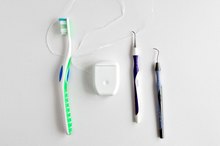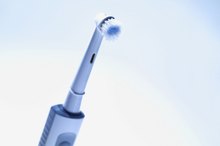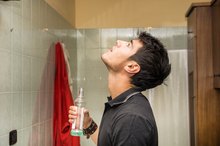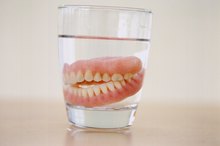What does fact checked mean?
At Healthfully, we strive to deliver objective content that is accurate and up-to-date. Our team periodically reviews articles in order to ensure content quality. The sources cited below consist of evidence from peer-reviewed journals, prominent medical organizations, academic associations, and government data.
- PubMed.gov: In Vitro Comparison of Restoration Wear and Tensile Strength Following Extended Brushing With Sonicare and a Manual Toothbrush; Donyl, KJ et al.
- PubMed.gov: In Vitro Comparison of Restoration Wear and Tensile Strength Following Extended Brushing With Sonicare and a Manual Toothbrush; Donyl, KJ et al.
The information contained on this site is for informational purposes only, and should not be used as a substitute for the advice of a professional health care provider. Please check with the appropriate physician regarding health questions and concerns. Although we strive to deliver accurate and up-to-date information, no guarantee to that effect is made.
Are There Any Problems With Sonic Toothbrushes?
Sonic toothbrush technology provides superior dental hygiene at home. The pulsating action of the sonic brush head works to clean between teeth and around the gum line to maintain your healthy, happy smile. Reviewers of today's top models attest to a high level of satisfaction among users and dental researchers. Few problems have been reported with sonic toothbrushes.
Technology
The bristles on a sonic toothbrush vibrate at a more than 30,000 brush strokes per minute. Sonic toothbrushes use two cleaning mechanisms: the conventional scrubbing action of the bristles and the vibratory agitation of oral fluids caused from the sonic technology. The combination of these cleaning methods results in a cleaner tooth surface and efficient plaque removal. A 2003 study entitled, "Effects of Dynamic Fluid Activity From an Electric Toothbrush on In Vitro Oral Biofilms," by C. K. Hope and Professor Michael Wilson at the Eastman Dental Institute for Oral Healthcare Sciences, concluded that an activated Philips Sonicare Plus toothbrush removed 20 times more viable bacteria than an inactivated toothbrush 2.
- The bristles on a sonic toothbrush vibrate at a more than 30,000 brush strokes per minute.
- Sonic toothbrushes use two cleaning mechanisms: the conventional scrubbing action of the bristles and the vibratory agitation of oral fluids caused from the sonic technology.
Types
How to Use Dental Tools at Home to Remove Plaque
Learn More
Philips Sonicare and Oral-B Pulsonic are two popular brands of sonic toothbrushes. According to a survey of reviews, the Consumer Search website named the triple-action Oral-B Professional Healthy Clean Precision 4000 as the Best Electric Toothbrush 2. This model oscillates, rotates and pulsates. Consumer Search named the Philips Sonicare for Kids as the Best Electric Toothbrush for Kids 2.
Misconceptions
Researchers have investigated the effects of high-speed sonic brush heads to determine if their pulsating actions cause damage to the tooth surface and dental work such as tooth fillings. One such study by K. J. Donly and associates in 1997 concluded, "There was no apparent wear of tooth structure or of restorative materials with either the Sonicare or the manual brush. There was a small loss of cement from the margins of the gold inlays following tooth brushing, which was similar and not significantly different between the sonic and manual brush."
Problems
Does a Waterpik Remove Tartar?
Learn More
Overall, users of sonic toothbrushes report no problems other than an initial oral tickling sensation that fades with subsequent use. As with any rechargeable product, it can be inconvenient to travel with an appliance that requires a plug-in receptacle. Also, you have to replace rechargeable batteries. The high cost of sonic toothbrushes can be a problem for some users.
- Overall, users of sonic toothbrushes report no problems other than an initial oral tickling sensation that fades with subsequent use.
- The high cost of sonic toothbrushes can be a problem for some users.
Advantages
There are several advantages to a sonic toothbrush 1. Sonic toothbrushes provide excellent plaque removal between professional dental cleanings. If you have children who need coaxing to brush their teeth, sonic toothbrushes can provide added motivation. If you have orthodontic appliances or oral conditions that make it hard to brush, such as crooked teeth, a sonic toothbrush might be more effective and comfortable than a regular toothbrush. If you have limited manual dexterity, brushing with a sonic toothbrush can be easier than brushing by hand.
- There are several advantages to a sonic toothbrush 1.
- If you have orthodontic appliances or oral conditions that make it hard to brush, such as crooked teeth, a sonic toothbrush might be more effective and comfortable than a regular toothbrush.
Related Articles
References
- Animated-Teeth.com: How Does a Sonicare Toothbrush Work?
- Consumer Search: Electric Toothbrush Reviews
- PubMed.gov: In Vitro Comparison of Restoration Wear and Tensile Strength Following Extended Brushing With Sonicare and a Manual Toothbrush; Donyl, KJ et al.
- American Dental Association. Shopping list of all products with the ADA Seal of Acceptance.
- American Dental Association. Toothbrushes. 2020.
Writer Bio
Rae Casto began writing professionally in 1982. She writes on a variety of topics including health, nutrition, art and culture for various websites. Casto holds a Bachelor of Arts in psychology and art from Guilford College and a Master of Public Administration in health administration from the University of North Carolina at Pembroke.









